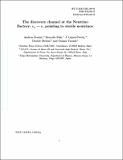Por favor, use este identificador para citar o enlazar a este item:
http://hdl.handle.net/10261/17827COMPARTIR / EXPORTAR:
 SHARE SHARE
 CORE
BASE CORE
BASE
|
|
| Visualizar otros formatos: MARC | Dublin Core | RDF | ORE | MODS | METS | DIDL | DATACITE | |

| Campo DC | Valor | Lengua/Idioma |
|---|---|---|
| dc.contributor.author | Donini, Andrea | - |
| dc.contributor.author | Fuki, Ken-ichi | - |
| dc.contributor.author | López-Pavón, Jacobo | - |
| dc.contributor.author | Meloni, Davide | - |
| dc.contributor.author | Yasuda, Osamu | - |
| dc.date.accessioned | 2009-10-20T10:55:59Z | - |
| dc.date.available | 2009-10-20T10:55:59Z | - |
| dc.date.issued | 2009-08-12 | - |
| dc.identifier.citation | Journal of High Energy Physics 08(041): (2009) | - |
| dc.identifier.issn | 1126-6708 | - |
| dc.identifier.uri | http://hdl.handle.net/10261/17827 | - |
| dc.description | 54 pages, 14 figures, 1 table.-- Pre-print archive. | - |
| dc.description.abstract | We study the potential of a Neutrino Factory in constraining the parameter space of a scheme with one sterile neutrino separated from three active ones by an O(1) eV2 mass-squared difference. We present approximated analytic expressions for the oscillation probabilities, showing that the greatest sensitivity to sterile neutrinos at a Neutrino Factory can be achieved using the νμ → νμ and the νμ → ντ oscillations. We have studied two setups: a Neutrino Factory with 50 GeV (20 GeV) stored muons, with two detectors of the Hybrid-MIND type (a magnetized ECC next to a magnetized iron calorimeter), located at L = 3000, 7500 km (L = 4000, 7500 km) from the source. Four channels have been used: νe → νμ,ντ; νμ → νμ,ντ. The relevant backgrounds, efficiencies and systematic errors have been taken into account, and we have discussed dependence of the sensitivities on the systematic errors. We have found that the 50 GeV (20 GeV) setup can constrain sin2 2θ(4fam)13 ≤ 7 × 10−5 (2 × 10−4); θ34 ≤ 12° (14°); and θ24 ≤ 7.5° (8°). Our results hold for any value of Δm2SBLgtrsim0.1 eV2. Eventually we have shown that, if a positive signal is found, the proposed setup is able to measure simultaneously θ34 and δ3 with a precision of few degrees and few tens of degrees, respectively, solving the so-called "intrinsic" and "sign degeneracies". Combination of νμ disappearance and of the νμ → ντ channel, that will be called "the discovery channel'', at the two baselines is able to measure at 99% CL a new CP-violating phase δ3 for sin2 2θ34 ≥ 0.06. | en_US |
| dc.description.sponsorship | We acknowledge H. Minakata for useful comments, M. Maltoni and P. Migliozzi for useful discussions, and P. Lipari and M. Lusignoli for discussions. The work has been partially supported by the JSPS-CSIC Bilateral Joint Projects (Japan- Spain), a Grant-in-Aid for Scientific Research of the Ministry of Education, Science and Culture of Japan,#19340062. K.F. thanks the support by the MEXT program ”Support Program for Improving Graduate School Education”; J. L.-P. acknowledges partial financial support by the Ministry of Science and Innovation of Spain (MICIINN) through an FPU grant, ref. AP2005-1185; A.D. acknowledges partial financial support by the Istituto Nazionale di Fisica Nucleare (INFN) through the Iniziativa Specifica RM21 for foreign guests; and by the MICINN through the research project FPA2006-05423 and through the INFN-MICINN-08 Bilateral Agreement (Italy-Spain) ”Flavour as a window for new physics”; D.M. acknowledges partial financial support by Ministry of University and of Scientific Research of Italy, through the 2007-08 COFIN program. A.D. and J.L.-P. acknowledge also financial support from the Comunidad Aut´onoma de Madrid through the project P-ESP-00346. Eventually, A.D., J.L.-P. and D.M. acknowledge the financial support of the European Community under the European Commission Framework Programme 7 Design Study: EUROnu, Project Number 212372; and under the Framework Programme 6 BENE-CARE networking activity MRTN-CT-2004-506395. The EC is not liable for any use that may be made of the information contained herein. A.D. and J.L.-P. thank the Physics Department of the Universit`a di Roma ”La Sapienza”, where this work has been completed. | en_US |
| dc.format.extent | 797145 bytes | - |
| dc.format.mimetype | application/pdf | - |
| dc.language.iso | eng | en_US |
| dc.publisher | Institute of Physics Publishing | - |
| dc.publisher | International School for Advanced Studies | - |
| dc.rights | openAccess | en_US |
| dc.subject | Solar and Atmospheric Neutrinos | en_US |
| dc.subject | Neutrino Physics | en_US |
| dc.subject | Beyond Standard Model | en_US |
| dc.title | The discovery channel at the Neutrino Factory: $\nu_\mu\to\nu_\tau$ pointing to sterile neutrinos | en_US |
| dc.type | artículo | en_US |
| dc.identifier.doi | 10.1088/1126-6708/2009/08/041 | - |
| dc.description.peerreviewed | Peer reviewed | en_US |
| dc.relation.publisherversion | http://dx.doi.org/10.1088/1126-6708/2009/08/041 | en_US |
| dc.type.coar | http://purl.org/coar/resource_type/c_6501 | es_ES |
| item.fulltext | With Fulltext | - |
| item.languageiso639-1 | en | - |
| item.openairecristype | http://purl.org/coar/resource_type/c_18cf | - |
| item.openairetype | artículo | - |
| item.cerifentitytype | Publications | - |
| item.grantfulltext | open | - |
| Aparece en las colecciones: | (IFT) Artículos | |
Ficheros en este ítem:
| Fichero | Descripción | Tamaño | Formato | |
|---|---|---|---|---|
| 0812.3703v2.pdf | 778,46 kB | Adobe PDF |  Visualizar/Abrir |
CORE Recommender
SCOPUSTM
Citations
28
checked on 20-abr-2024
WEB OF SCIENCETM
Citations
31
checked on 26-feb-2024
Page view(s)
370
checked on 24-abr-2024
Download(s)
137
checked on 24-abr-2024
Google ScholarTM
Check
Altmetric
Altmetric
NOTA: Los ítems de Digital.CSIC están protegidos por copyright, con todos los derechos reservados, a menos que se indique lo contrario.
